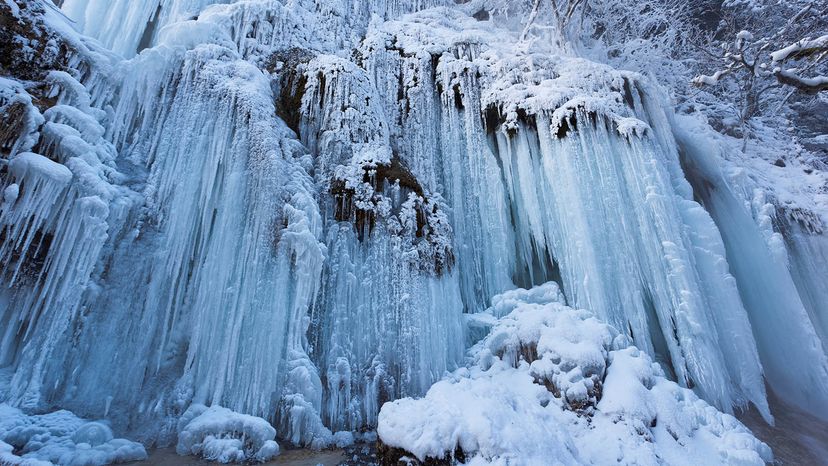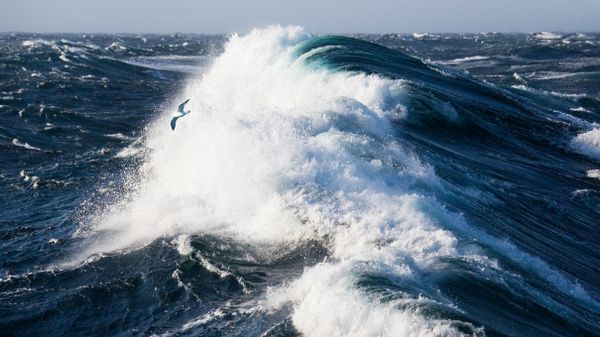
Hell might freeze over someday, but Niagara Falls probably won't. The roaring landmark sits on the border of upstate New York and Ontario, Canada. It consists of three separate waterfalls, with the tallest being 167 feet (51 meters) high.
The cascading waters have attracted the odd daredevil over the years — we've all heard the stories about thrill-seekers in barrels. But most visitors simply come to admire their natural beauty. In the wintertime, the falls get extra gorgeous — because icy formations often appear on or around them.
Advertisement
Yet despite all claims to the contrary, Niagara Falls doesn't ever fully freeze.
Freezing Niagara Falls solid would be quite a feat, you see. During the winter, a whopping 22.4 million gallons (85 million liters) of water tumble over the falls per minute. Scientists say it'd be extremely difficult to freeze that much fast-flowing water, even in subzero temperatures.
So how do we explain spellbinding photos like these?
Well, Niagara Falls generates an awful lot of mist, as the "Maid of the Mist" boat tour will happily remind you. Under the right weather conditions, those water droplets are liable to freeze as they accumulate on the trees, boulders and railings that surround the falls.
Also, there are days when a thin layer of frozen spray and mist hardens over the falls. Right beneath this icy blanket, however, you'll still find plenty of liquid water flowing on its usual downward path.
Bottom line: Niagara Falls isn't going to freeze all the way through anytime soon. But that's just one landmark. Let's talk about some other waterfalls.
On a cold morning in January 2018, physics professor Michael J. Ruiz and independent researcher Charles Cranford filmed a 65-foot (20-meter) waterfall in North Carolina that had mostly frozen. Trickling over some of the ice was a stream of supercooled water.
Supercooled water is water that remains liquid below the normal freezing temperature of H2O: 32 degrees Fahrenheit (or 0 degrees Celsius).
It was significantly colder outside when Ruiz and Crawford recorded their video; the local temperature was just 5 degrees F (-15 degrees C). Under those conditions, even the supercooled water couldn't stay liquified for long.
In this amazing footage captured by the duo, you can actually watch flowing, supercooled H2O at the Carolina waterfall freezing into ice in real time. And not just any ice. The water was hardening into a clumping collection of tiny, needle-shaped crystals. Meteorologists call that frazil ice.

Often associated with turbulent, supercooled water, frazil ice can also develop when mist droplets freeze. The ice is a common sight around certain waterfalls — like the ones at California's Yosemite National Park — in below-freezing weather. When frazil ice clings to a rocky surface, it can become a platform for even more ice to build up.
Know what else can build up? Waterfall icicles. Found in many regions of the globe, from France to Utah, they can take many forms. Spend enough time exploring and you might see ice stalactites dangling off cliffs — or ice stalagmites ascending from the ground below.
And if a lowering stalactite touches a rising stalagmite, you get a column-like ice pillar. Magnificent.
(Be warned: Icicles — and ice pillars — can be dangerous. On Jan. 7, 2021, a large one nicknamed the "Tsar Icicle" that had developed on Russia's Vilyuchinsky Waterfall abruptly collapsed. Several tourists were trapped when the structure broke and, sadly, one man was killed.)
Now if you see icy stalactites, stalagmites or pillars gathered around your favorite waterfall, it doesn't mean the whole waterfall has frozen solid. That only happens when the source of the waterfall freezes through, whether that's a creek, stream or river. The larger and faster-flowing a given source is, the smaller its chances of becoming frozen.
Advertisement
